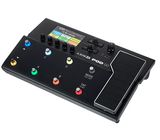Hardware:
- The pedalboard itself has a very well-made construction in very resistant steel in addition to very firm and solid switches. Which gives the impression of stepping on a category A pedal, such as the Kempers.
- The LCD screen was also very well put together and the layout of the buttons and their usability transform the simple experience of editing an effect.
Software:
- The pedal board software was very well developed, and it has mechanics of use similar to what they did on the Helix, which is very cool and very advantageous for a pedalboard of this price.
- Very simple to edit and assemble your presets, save them and even back up your pedalboard. As a result, trading effects with my friends has become a hobby.
PodGo Edit:
- I tested the Windows version and didn't find great things there. The GUI part needs some finishing touches on the UI-UX layer. Furthermore, it is simple and intuitive to use. You can quickly set your effect, test it on the fly, and save it to your pedalboard.
- It fulfils its objective very well in simplicity, but it is not one of the most beautiful on the market.
Cost vs. Benefit:
- To be honest, I saw very little difference between it and Helix (apart from the fact that Helix has a greater number of presets and even slightly higher quality in the hardware). So, if I were going to buy a new pedalboard today, I would go with the PodGO.
- In my humble opinion it was worth every penny, and I still think this pedal is being marketed very cheaply, for what it offers to end consumers.

